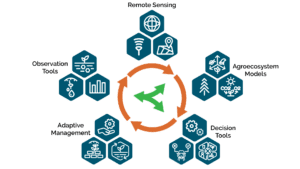A model for the functionings of an agricultural system, with all inputs and outputs. An ecosystem may be as small as a set of microbial interactions that take place on the surface of roots, or as large as the globe. An agroecosystem may be at the level of the individual plant-soil-microorganism system, at the level of crops or herds of domesticated animals, at the level of farms or agricultural landscapes, or at the level of entire agricultural economies.
How is adaptive management in agriculture integrated into the OpenTEAM platform?
Adaptive Management is a process of continual improvement by adjusting “action” based on high frequency observations and data driven analysis rather than by expert opinion, best practice recipe or prescription. It requires a high level of system understanding and observation, analysis and communications feedback.

What is soil health?
Soil health is an assessment of how well soil performs all of its functions now and how those functions are being preserved for future use. Soil health cannot be determined by measuring only crop yield, water quality, or any other single outcome but is evaluated through indicators.
Indicators are measurable properties of soil or plants that provide clues about how well the soil can function. Indicators can be physical, chemical, and biological properties, processes, or characteristics of soils. They can also be morphological or visual features of plants.
What is regenerative agriculture?
Regenerative agriculture is a holistic, place-based approach to farming and food that prioritizes a healthy environment. Building on Indigenous understandings, skills, and philosophies that have been passed down over generations, regenerative agriculture restores ecosystems, communities, and economies to ensure resiliency. It builds healthy soils, reduces air pollution, conserves water, and increases biodiversity while supporting farmers’ ability to produce food for their community.
Regenerative agriculture is a collaborative effort that requires cooperation and partnership among stakeholders to build healthy, sustainable, and resilient food systems. While practices are farm and region specific, there is a commitment to shared principles to achieve long-term outcomes. These principles include:
- Minimize soil disturbance
- Maintain living soils year round
- Keep soil covered
- Maximize crop diversity
- Integrate livestock
Some examples of common practices include managed rotational livestock grazing, use of cover crops, and minimal soil disruption. These practices require knowledge-sharing and collaboration among farmers to effectively implement and maintain them, and an educated consumer base to help support.

